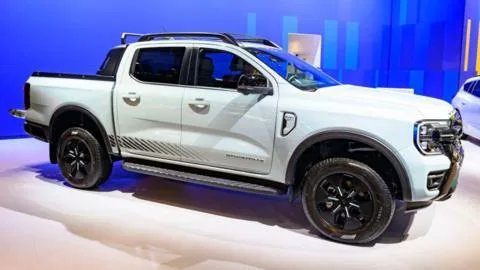Exploring the Reasons Behind Lower European Purchases of American Cars
Large American pickup trucks often struggle to navigate through Europe’s historic towns and cities, particularly those with narrow, cobbled streets. This makes it challenging for them to be popular among European consumers despite US President Donald Trump’s criticism that Europeans do not buy enough American vehicles. The disparity in fuel prices between the United States and Europe also contributes to this situation.
Hampus Engellau, a car industry analyst from Swedish investment bank Handelsbanken Capital Markets, explains why navigating Italy with an SUV can be particularly challenging: “Try driving around Italy in a big SUV. I’ve done it, and it’s very difficult.” Additionally, Mike Hawes, CEO of The Society of Motor Manufacturers & Traders (SMMT), which represents the industry in the UK, notes that Europeans tend to prefer smaller, more fuel-efficient vehicles due to higher fuel prices compared with their American counterparts.

Despite these challenges, European carmakers have gained significant market share in the US. In 2022, 692,334 new EU-made cars were exported to the US for €36bn ($37bn; £30bn), while only 116,207 new US-made vehicles went in the opposite direction, worth €5.2bn. This imbalance has prompted Trump to blame unfair trading rules and suggest raising tariffs on European automotive imports.

The EU’s current 10% tariff on cars imported from the US is significantly higher than America’s 2.5% tariff on EU car imports. While Mr Engellau agrees that trade terms are not equal, he adds that reducing tariffs might protect Europe’s automotive industry from a potential trade war.

The automotive industry veteran Andy Palmer believes the focus on global trade may be misplaced and suggests it is better to manufacture closer to where customers reside: “If you can help it, you don’t want to ship cars around the world. They’re big boxes of expensive air.” Several European carmakers have begun manufacturing larger vehicles in North America, then exporting them back to Europe.
For example, Ford plans significant job cuts in the UK and Germany by 2027 due to a shift towards electric and commercial vehicles away from small, affordable cars. Meanwhile, Tesla operates a factory near Berlin that produces its Model Y for the European market; however, low-cost Chinese imports are gaining ground in Europe’s electric car segment.
Europe’s diverse marketplace presents challenges for overseas carmakers because of different taxation regulations, language barriers, and competitive local brands like BMW and Mercedes in Germany. Jose Asumendi from JP Morgan notes that customers often prefer homegrown brands due to a natural inclination towards national champions. Additionally, he observes the market is crowded with Japanese, South Korean, and Chinese vehicles.
In summary, while Mr Trump aims to bolster America’s car industry through tariffs and production closer to home markets, experts argue these measures may stifle innovation rather than strengthen it by isolating companies from competitive pressures in the free market. Andy Palmer emphasizes that investment and collaboration are more crucial factors for success in the global automotive sector.

